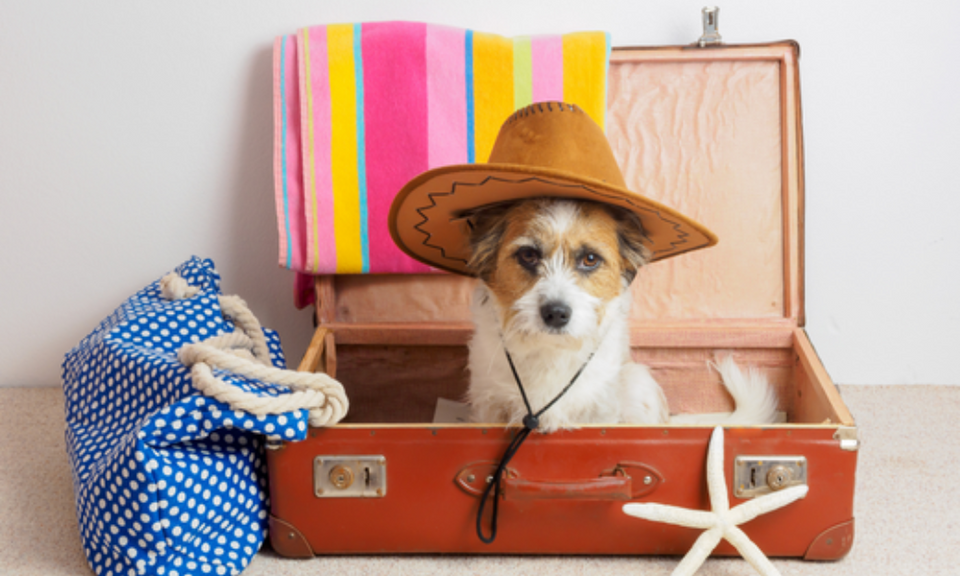
How to Travel With Your Pet

As vacation time rolls around, you may be planning your next family time away and, if you’re like most pet parents, you’ll want to include your fur-babies on the excursion, rather than leave them home with a sitter or have to board them for the time you’re going.
But, just as with travel plans for adults and children, our pets require their own special preparation and add a different set of complications. At the same time, having them with us during our time off also adds a whole lot of extra love and memories to the trip, and that is worth whatever it takes to make it happen safely.
Before you start packing
The key to traveling with pets is preparation. You need to know the answers to these questions: Where are you going, how are you getting there and back, and where will you be staying?
Each answer can make a really big difference in how you approach the trip. Are you crossing state or international borders, for example? That will affect the documentation and quarantine requirements. Are you going to a jurisdiction that has a ban in effect on your breed of dog, and does that count for visiting dogs as well? How dog-friendly is your destination in general?
How you’re getting there comes with its own set of “what ifs,” with private vehicles offering the most options and bus lines the most limited — the latter mostly have “no dogs but service dogs” policies. Railways and airlines fall in the middle.
Finally, your destination will make a difference. Can you find a pet-friendly hotel, motel, or short-term rental where you’re going? Or, if you’re staying with friends or family, do they allow dogs, do they have pets of their own, or is anyone in the household allergic? Are the yards in their neighborhood fenced or unfenced, and are there any local dangers, like wildlife?
In cases where you are receiving hospitality from friends or family, the first thing you need to do is ask them whether you can bring your dogs or cats, then respect their answer. The worst thing you could do is just show up with the fur kids in tow and no warning.
All right, so now you’ve made your list of where you’re going, how you’re traveling and where you’re staying. Time to get into the specifics.
Planes

While most airlines do allow pets in the cabin with you, there are limitations. They have to be small enough to travel in a carrier that will fit under the seat in front of you, in which case they’re considered to be carry-on luggage. The rules are the same for dogs and cats. This also means that, realistically, you’d only be able to bring your pet on board if you have a toy breed of dog or a very small cat or kitten.
Otherwise, if you want to take your pets on a plane, they are considered cargo and are shipped in the hold. Fortunately, this doesn’t mean they’re packed in a box and tossed in with the luggage. They do have pressurized and temperature-controlled cargo holds for such purposes.
However, if you’ve ever had luggage lost or damaged on a flight or had it wind up in the wrong city, the idea of shipping your pet the same way can be very disconcerting. For some travelers, it has turned into a total nightmare, ranging from their pets not being handled as promised to them not surviving the trip.
Additionally, while they travel in pressurized cargo bays, things can and will still shift around while the plane is in motion, which at the very least can startle a dog or cat but in the worst case scenario upend or damage their carrier. Also, since there are no windows, it can be very disconcerting for any animal to feel the “room” suddenly moving around in an unpredictable manner, like a non-stop earthquake that lasts for hours.
So if you do need to fly and can’t bring your pet onboard, do your research on an airline’s reputation and track record with transporting dogs and cats. You’re the only one who can decide what you’re comfortable with, so check around first.
Trains
You can bring pets onto Amtrak trains provided that the combined weight of the dog or cat plus their carrier is less than 20 pounds so, again, you’re limited to a very small traveling companion.
Also keep in mind, though, that the trip also must be seven hours or less, so this limits how far you can go on a single leg of the journey.
For both passenger trains and commercial flights, crossing state lines or international borders will require a health certificate from your vet stating that they are free of infectious diseases and healthy enough to travel.
Domestic travel within the U.S. is regulated by the individual state you’re arriving in while international travel must be cleared by the U.S. Department of Agriculture. However, private carriers also have their own requirements, so check with your specific airline or train company first.
Automobiles

Traveling in your own vehicle naturally offers the greatest freedom and fewest restrictions on your pets. As a bonus, it’s a travel method that your dog or cat is probably already familiar with and with which they generally have happy associations — except for those vet trips, of course.
PetMD has a checklist for preparing for a road trip with a dog along with a list of essentials to bring which is easily adaptable to a cat — for example, ditch the poop bags, but bring a portable (and sealable) litter box.
While you’re on the road, you’ll want to keep to your pets’ normal schedule for walking and feeding, which means that you’ll need to figure out when and where you’ll be stopping for walk breaks and mealtimes. You’ll also need to take your dog on a walk or give your cat a litter break before each day’s journey begins if you’re making a multiple-day trek.
Also vitally important: your dog may be used to having free rein in the back seat on short, in-town trips, but for long distance the safest option is a crate that’s belted to the seats. If that’s not feasible due to size limitations, consider a car seat cover or dog car bed that securely keeps your pup in place.
If your dog isn’t used to traveling this way, then you’ll need to acclimate them to it before your trip begins so that it doesn’t cause them undue stress or anxiety.
Finally, there’s the most important note to put on your door so you’ll see it before you leave: If your pets will be eating wet food, don’t forget the can opener!
On the road
Make sure that your pets stay cool and hydrated. Try to keep their carrier out of direct sunlight, and make sure they get plenty of water.
If your dog or cat is prone to motion sickness, there are things you can do to help decrease or eliminate it. One is to limit food intake before the trip. Another is to make sure that they face forward while traveling so that what they see doesn’t conflict with what they feel. The center back seat is ideal for this if you have a split console or separate front seats.
It can help to have something familiar in the crate that smells like home. This can help to calm your pet. Also, crack the back windows a couple of inches. This will allow fresh air to enter and equalize the air pressure. Finally, there are medications to help prevent motion sickness, some prescription and some not. As always, consult with your vet.
As noted previously, stop at appointed times and locations to give your pets a break, and keep them on leashes when you get out of the car. Yes, cats, too. The last thing you want is a pet running off in a strange place far from home.
You can check for pet friendly stopping places along your route at a site like Bring Fido, and research pet friendly hotels, motels, and other lodging at sites like Pets Welcome.
If you’re inclined to go camping with your pets, that’s also doable although probably only advisable if you’ve already had plenty of camping experience yourself. Learn how to prepare and go camping from Chewy.
If you just want to take a road trip but have no idea where to, then Go Pet Friendly has you covered with their list of nine regional road trips that are great for bringing along dogs. They can also tell you where to find the best pet friendly national parks in the U.S.
Bringing it home
When done right, traveling with your pets can be easy and fun. It’s also well worth the effort because it allows you to bring the whole family along, leaving you to enjoy your vacation without missing or worrying about your fur babies back home. It’s a great opportunity for some bonding and can ultimately be a very pawsitive activity.
Share this article
written by


